BRILLIANT BREADMAKING IN YOUR BREAD MACHINE
Catherine Atkinson A How To Book

ROBINSON First published in Great Britain in 2013 Spring Hill,
an imprint of How To Books Ltd This edition published in 2019 by Robinson Text Catherine Atkinson 2013 The moral right of the author has been asserted. All rights reserved. No part of this publication may be reproduced, stored in a retrieval system, or transmitted, in any form, or by any means, without the prior permission in writing of the publisher, nor be otherwise circulated in any form of binding or cover other than that in which it is published and without a similar condition including this condition being imposed on the subsequent purchaser. A CIP catalogue record for this book is available from the British Library. ISBN: 978-1-47214-400-3 Produced for How To Books by Deer Park Productions, Tavistock, Devon Edited by Wendy Hobson Robinson An imprint of Little, Brown Book Group Carmelite House 50 Victoria Embankment London EC4Y 0DZ An Hachette UK Company www.hachette.co.uk www.littlebrown.co.uk NOTE: The material contained in this book is set out in good faith for general guidance and no liability can be accepted for loss or expense incurred as a result of relying in particular circumstances on statements made in the book. Laws and regulations are complex and liable to change, and readers should check the current position with relevant authorities before making personal arrangements.
How To Books are published by Robinson, an imprint of Little, Brown Book Group. We welcome proposals from authors who have first-hand experience of their subjects. Please set out the aims of your book, its target market and its suggested contents in an email to Contents The author and publisher would like to thank the following companies who lent equipment for testing or provided flours and bread-making ingredients. Kenwood www.kenwoodworld.com Morphy Richards www.morphyrichards.co.uk Lakeland Limited Alexandra Buildings, Windermere, Cumbria, CA23 1BQ 01539 488100 www.lakelandlimited.com A wide range of bread-making equipment, including bread machines, bread mixes, bread storage bags and boxes. Available by mail order online and from their many shops. Doves Farm Salisbury Road, Hungerford, Berkshire, RG17 0RF 01488 684880 www.dovesfarm.co.uk A huge range of flours and bread making ingredients, all available by mail order.
Organic flour and gluten-free specialists. Claybrooke Mill Claybrooke Magna, Lutterworth, Leicestershire, LE17 5DB 01455 202443 www.claybrookewatermill.co.uk Many organic and non organic and stoneground flours, including French flour, unusual blends and mixes and other bread making ingredients. Mail order available.  Nothing beats the wonderful aroma of freshly baked bread, but in todays busy society few of us have the time to make it from scratch. Now all the laborious mixing, kneading, proving and baking can be done by your bread machine. All you need to do is to weigh out a few simple ingredients and let the machine do the work, creating loaves with maximum flavour and minimum fuss.
Nothing beats the wonderful aroma of freshly baked bread, but in todays busy society few of us have the time to make it from scratch. Now all the laborious mixing, kneading, proving and baking can be done by your bread machine. All you need to do is to weigh out a few simple ingredients and let the machine do the work, creating loaves with maximum flavour and minimum fuss.
The benefits of home-baked bread are obvious. Not only do you get warm and fresh bread from your machine, you know exactly whats in it no additives or preservatives, only wholesome ingredients in a loaf created to suit your personal preferences. With over 100 recipes to choose from, there are plenty of breads here that you wont find on every supermarket shelf, from the simplest farmhouse white and traditional wholemeal loaf to speciality breads made with flours such as spelt and rye and all manner of flavoured breads; the only limit is your imagination! Whether youre searching for a healthy brunch or lunchbox bread, sweet tea-time treat, or must-have dinner party accompaniment, youll find something to suit in the following chapters. This book takes you through the basic techniques and demystifies all that is essential to making good bread. A comprehensive introduction provides advice on different settings and programmes. Troubleshooting questions and answers will guide you through bread-making dilemmas to help you get perfect results every time.
Most of the recipes in the following chapters have three sets of ingredients, allowing you to make an average medium-sized loaf or, if you prefer, you can bake a larger loaf or a small one in a compact bread machine. Whichever type, flavour or size of loaf you choose, those you bake yourself will be infinitely more satisfying than bought baked bread. Bread machines take all the hard work out of making bread. Your machine will mix and knead the dough and ensure that it rises and bakes at the right temperature. To make most of the breads in this book, all you need to do is add the ingredients in the right order, decide the colour of the crust and press the start button. In just a few hours you will have a perfectly baked loaf.
Like most kitchen appliances, there are many different bread-making machines to choose from. They all work on the same basic principles, and current models all have a white bread, wholewheat, dough and rapid setting. Less expensive machines tend to have fewer programmes compared with those that may cost two or three times as much, so as well as price and appearance, you need to decide which features you would find essential or useful, such as extra settings for gluten-free bread, cake-baking or jam-making. If you want to make a lot of breads with seeds, nuts or dried fruits, you may find an automatic dispenser handy, and if you cant resist peeking at your loaf while it rises and bakes, a viewing window is a must. One of the most important factors to consider is the size and shape of the finished loaf, which is determined by the bread pan. Bread machine loaf sizes can vary from 450g to a massive 1.5kg, although most machines have no more than three loaf-size settings: small (450500g), medium or standard (750800g) and large (900g1kg).
The majority of the recipes in this book are geared towards making a standard 750g loaf, but most also give quantities of ingredients needed for a larger 900g1kg and a small 375500g (compact size) as well. Most people opt for a medium-sized machine, and these tend to have a tall, slightly square bread pan. Loaves cooked in these machines can be turned on their side for slicing into square slices. For these machines, simply follow the quantities of ingredients listed first, although you should also be able to make a larger or smaller loaf, if you prefer. Larger machines tend to make a rectangular loaf, like traditional farmhouse bread. In these machines, it is best to follow the standard or large set of ingredients.
You can make a small loaf in a large machine but it will be shaped like a classic loaf in length and width, but only half the height, which is not quite so successful. Compact bread machines will only make a small loaf (although you can, of course, make more loaves when you are catering for a lot of people!) For these machines, you should use the quantities given for small loaves, as these are specially designed for these small machines. For some machines, you can also buy a round bread pan as an additional extra, which are fantastic for making traditional milk bread and speciality loaves such as panettone. A bread machine takes up a fair amount of room, so choose a machine that you can either store easily or that fits the space you have available. If you are planning to keep it on a kitchen surface and aesthetics are important, you may also want to choose something that fits into the style of your kitchen and matches your other appliances. Many models are available in white, black or stainless steel.

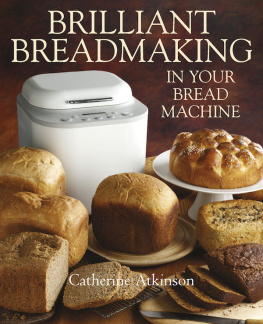
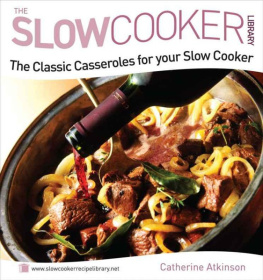
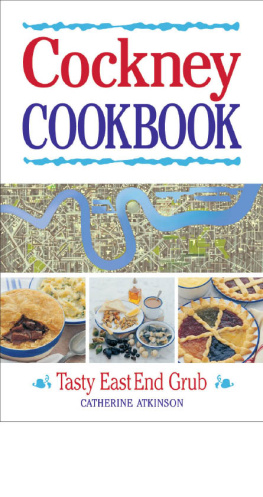
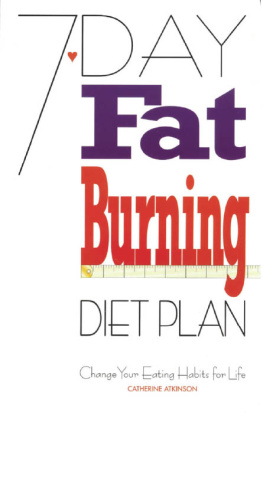
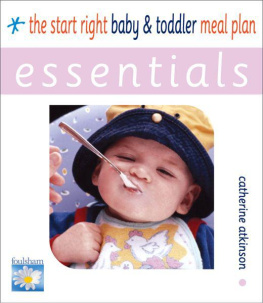
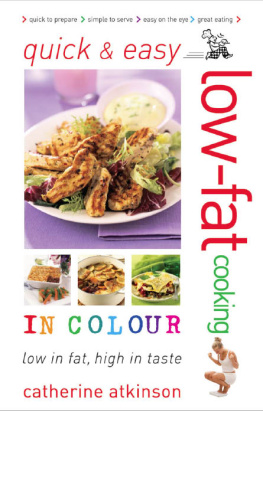
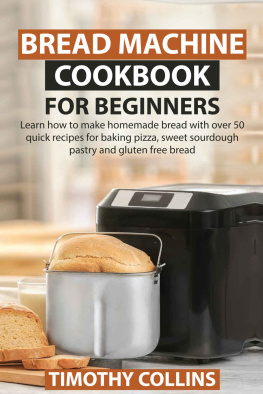


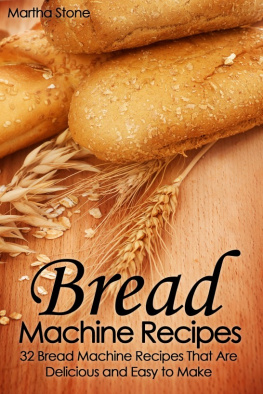


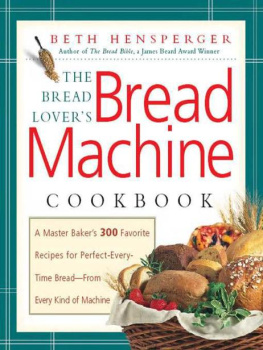
 ROBINSON First published in Great Britain in 2013 Spring Hill,
ROBINSON First published in Great Britain in 2013 Spring Hill, Nothing beats the wonderful aroma of freshly baked bread, but in todays busy society few of us have the time to make it from scratch. Now all the laborious mixing, kneading, proving and baking can be done by your bread machine. All you need to do is to weigh out a few simple ingredients and let the machine do the work, creating loaves with maximum flavour and minimum fuss.
Nothing beats the wonderful aroma of freshly baked bread, but in todays busy society few of us have the time to make it from scratch. Now all the laborious mixing, kneading, proving and baking can be done by your bread machine. All you need to do is to weigh out a few simple ingredients and let the machine do the work, creating loaves with maximum flavour and minimum fuss.